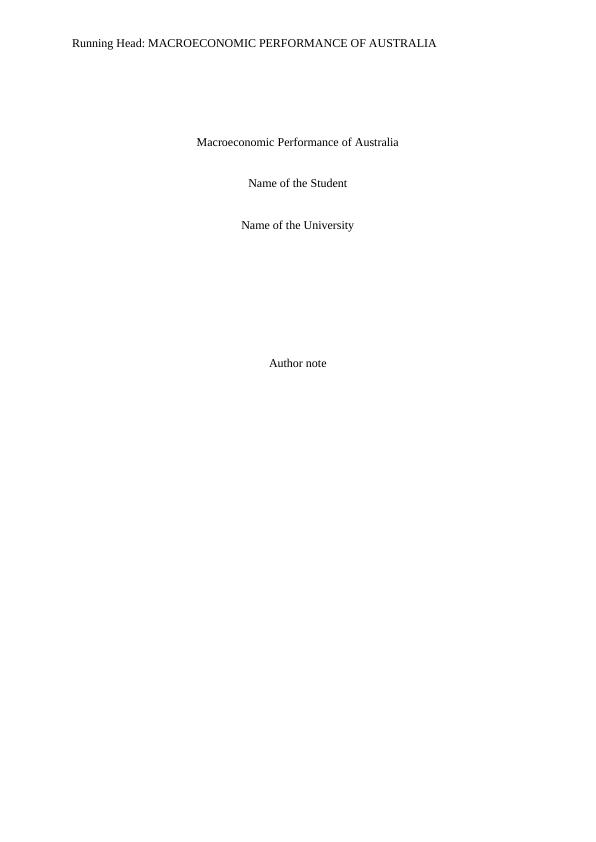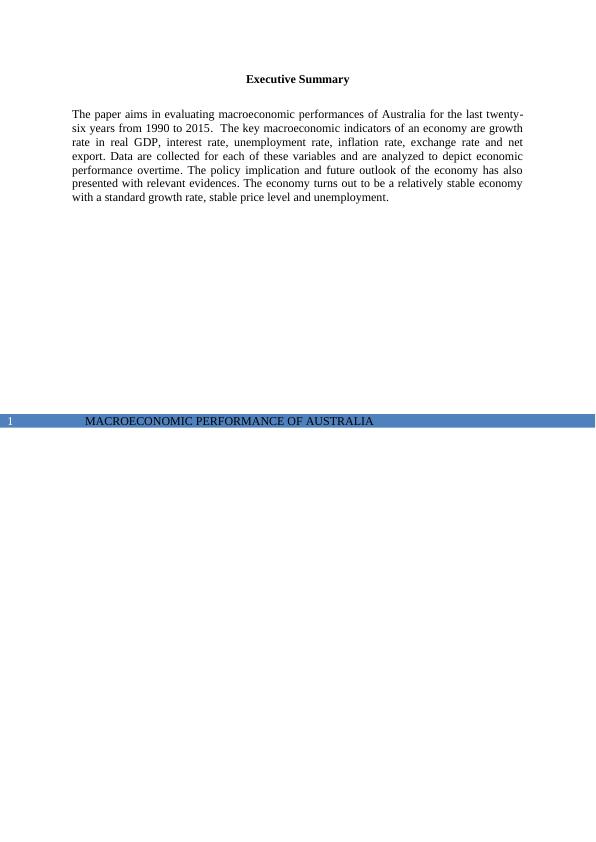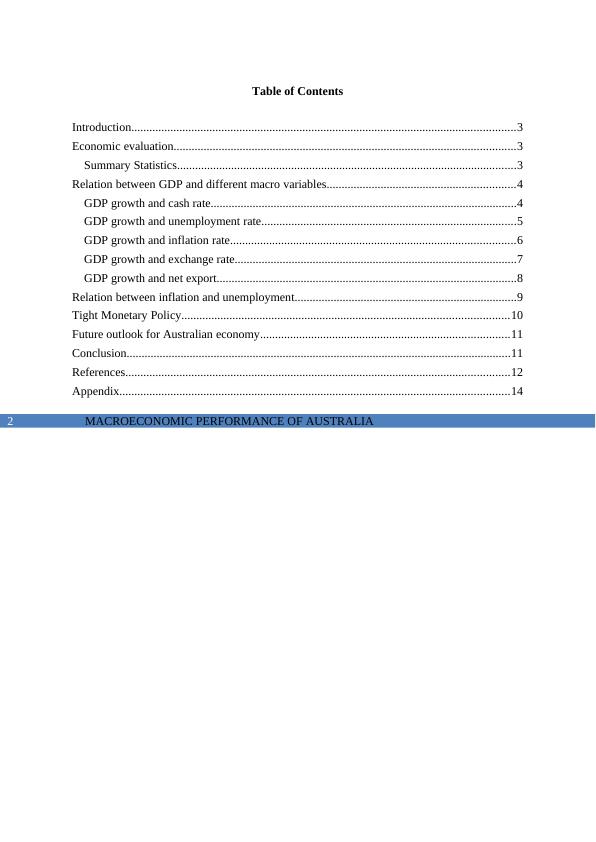BUS700 Economic Assignment: Macroeconomic Performance
Added on 2020-05-28
14 Pages3724 Words40 Views
Running Head: MACROECONOMIC PERFORMANCE OF AUSTRALIAMacroeconomic Performance of AustraliaName of the StudentName of the UniversityAuthor note

MACROECONOMIC PERFORMANCE OF AUSTRALIA1Executive Summary The paper aims in evaluating macroeconomic performances of Australia for the last twenty-six years from 1990 to 2015. The key macroeconomic indicators of an economy are growthrate in real GDP, interest rate, unemployment rate, inflation rate, exchange rate and netexport. Data are collected for each of these variables and are analyzed to depict economicperformance overtime. The policy implication and future outlook of the economy has alsopresented with relevant evidences. The economy turns out to be a relatively stable economywith a standard growth rate, stable price level and unemployment.

MACROECONOMIC PERFORMANCE OF AUSTRALIA2Table of ContentsIntroduction................................................................................................................................3Economic evaluation..................................................................................................................3Summary Statistics.................................................................................................................3Relation between GDP and different macro variables...............................................................4GDP growth and cash rate......................................................................................................4GDP growth and unemployment rate.....................................................................................5GDP growth and inflation rate...............................................................................................6GDP growth and exchange rate..............................................................................................7GDP growth and net export....................................................................................................8Relation between inflation and unemployment..........................................................................9Tight Monetary Policy.............................................................................................................10Future outlook for Australian economy...................................................................................11Conclusion................................................................................................................................11References................................................................................................................................12Appendix..................................................................................................................................14

MACROECONOMIC PERFORMANCE OF AUSTRALIA3Introduction Australian economy is one of the highly developed nation of world. The economy hasthe structure of a mixed market economy. The economy has recorded an uninterruptedgrowth rate for the last few decades making it 14 largest economies in world. The economy islargely dominated by the service sector. Service sector alone contributes 61.1 percent of totalGDP. More than 70 percent of the labor force is engaged in service sector. Because of thewidely spread market structure it has become an attractive export destination. The nation hasa huge stock of natural resources with mining industry has made a significant contribution inGDP. Both manufacturing and service sector are the main pillars of economic resilient inAustralia. Economic evaluation Gross Domestic Product (GDP) of an economy is a measure of monetary valuation ofgoods and services produced in a nation. GDP is one important attribute of economic growth.An increasing trend indicates toward an economic growth. There are several componentsdetermining GDP of a nation. Some are directly linked with GDP while others have anindirect connection (Hubbard and O'brien, 2015). The economic variables having direct orindirect relation with GDP growth rate are interest rate (cash rate), inflation, unemployment,exchange rate and net export. Summary StatisticsThe data for last 26 years on each of the above-mentioned indicators are collected.The basic statistics of the variables are summarized as follows. Real GDP is a GDP measurethat is computed using a fixed base year. This is an inflation-adjusted measure of GDP. Therate of change in real GDP between two consecutive years is called growth in real GDP. Theaverage real GDP growth in Australia is 3.11%. During this span, the highest growth rate isaccounted in 1999 with a growth rate of 5.01%. The nation accounted a negative growth rateof -0.38% in 1991.The interest rate that Reserve Bank of Australia charges on loans given to other banksin the economy is known as the cash rate. The cash rate for the chosen period is averaged at arate of 5.63%. As shown from the data the highest cash rate is charge in 1990 with a rate of15.23 and recently in 2015, the cash rate reached to a recorded low level of 2.13%. As far as unemployment rate is concerned, the average unemployment rate is 6.77%.The unemployment rate reached to its peak level in 1994 and lowest rate of unemployment isrecorded in 2008 with a recorded rate of 4.40%. Australia has maintained a more or lessstable price level with inflation rate averaged around 2.73%. For the given time period theinflation rate was stared with a highest rate of 7.27% in 1990. In the samedecade, in 1997 theprice level has reached to its lowest level of 0.25%. The next two variables considered are exchange rate and net export. These twovariables are inter related. In times of currency depreciation, export increases and importdecreases causing a rise in net export. The exchange rate between Australian dollar and USdollar are taken. Australia and US share a strong trade relation (Berger-Thomson andChapman 2017). The average exchange rate between the two nations is 1.35. Australiandollar highly appreciated in 2011 and 2012. During this time Australian dollar valued 0.97per unit of US dollar. In 2001, Australian dollar depreciated maximum with exchange ratebeing 1.93.

End of preview
Want to access all the pages? Upload your documents or become a member.
Related Documents
Macroeconomics Indicators Australialg...
|17
|3641
|103
Comparative Analysis of Macroeconomic Performance of Australia and USAlg...
|21
|4999
|495
Performance Trend of Australian Economy: Analysis of GDP Growth, Inflation, Unemployment, Net Export, and Exchange Ratelg...
|14
|4385
|276
Macroeconomic Performance of Australia from 1990 to 2016lg...
|13
|3611
|62
Macroeconomics Performance of Australialg...
|14
|4190
|34
Australian economy and its relation with USAlg...
|11
|3532
|157
